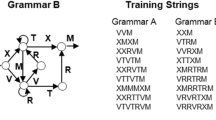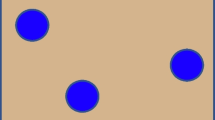Abstract
In several studies it has been found that implicit sequence learning is impaired by the concurrent performance of a secondary task. In most studies the task was to count high-pitched tones when high-pitched and low-pitched tones were presented in a random sequence. In this paper the hypothesis is examined that dual-task interference in the particular combination of tasks results from task integration, in particular from the learning of an integrated visual-auditory sequence in which every second (auditory) element is random. Instead of the tone-counting task a similar go/no-go task was used in which foot responses to high-pitched tones were performed. In Exp. 1 the sequence of tones was random in one condition, but in two other conditions repeated tone sequences of 5 and 6 elements were combined with visual sequences of 6 elements. Under dual-task test conditions, implicit learning of the visual as well as the auditory sequences was better with the auditory sequence of 6 elements than of 5 elements, while under single-task test conditions the nature of the tone sequence had no effect. In Exp. 2 the superior implicit learning with the 6-element sequence was replicated with different test procedures in which either the visual or auditory sequence was changed to random or in which the two sequences remained intact but were shifted by one element relative to each other. Randomization of the visual or auditory sequences not only impaired visual or auditory RT, respectively, but also impaired RT to stimuli in the other modality, and this cross-modal effect was almost as strong as the intra-modal effect of randomization. Finally, in Exp. 3 it was shown that integrated visual-auditory sequences are learned only when responses to both of them are required, but not when the tones can be neglected. These results are consistent with a conception of implicit learning as (at least partly) a basic and nonselective type of learning of all potentially behaviorally relevant relations between stimuli in the environment and one's own actions.
Similar content being viewed by others
References
Berry, D. C., & Broadbent, D. E. (1988). Interactive tasks and the implicit-explicit distinction. British Journal of Psychology, 79, 251–272.
Cohen, A., Ivry, R. I., & Keele, S. W. (1990). Attention and structure in sequence learning. Journal of Experimental Psychology: Learning, Memory, and Cognition, 16, 17–30.
Curran, T., & Keele, S. W. (1993). Attentional and non-attentional forms of sequence learning. Journal of Experimental Psychology: Learning, Memory, and Cognition, 19, 189–202.
Damos, D. (1991). Dual-task methodology: Some common problems. In: D. L. Damos (Ed.), Multiple-task performance. (pp. 101–119) London: Taylor & Francis.
Frensch, P. A., Buchner, A., & Lin, J. (1994). Implicit learning of unique and ambiguous serial transitions in the presence and absence of a distractor task. Journal of Experimental Psychology: Learning, Memory, and Cognition, 20, 567–584.
Goschke, T. (1994, March) Prozedurales Lernen von strukturierten Ereignissequenzen. Paper presented at the workshop “Sequenzlernen, Bewußsein and Aufmerksamkeit”, Schwerte, Germany.
Hay, J. C., & Goldsmith, W. M. (1973). Space-time adaptation of visual position constancy. Journal of Experimental Psychology, 99, 1–9.
Hayes, N., & Broadbent, D. E. (1988). Two modes of learning for interactive tasks. Cognition, 28, 249–276.
Held, R., Efstathiou, A., & Greene, M. (1966). Adaptation to displaced and delayed visual feedback from the hand. Journal of Experimental Psychology, 72, 887–891.
Heuer, H. (1985). Some points of contact between models of central capacity and factor analytic models. Acta Psychologica, 60, 135–155.
Heuer, H. (1996) Doppeltätigkeiten. In: O. Neumann & A.F. Sanders (Eds.), Enzyklopädie der Psychologie C II 2: Aufmerksamkeit (pp. 163–218). Göttingen: Hogrefe.
Heuer, H., & Schmidtke, V. (1996). Secondary-task effects on sequence learning. Psychological Research/Psychologische Forschung, 59, 119–133.
Heuer, H., Schmidt, R. A., & Ghodsian, D. (1995). Generalized motor programs for rapid bimanual tasks: A two-level multiplicative-rate model. Biological Cybernetics, 73, 343–356.
Kahneman, D. (1973). Attention and effort. Englewood Cliffs, N.J.: Prentice-Hall.
Keele, S. W., & Jennings, P. J. (1992). Attention in the representation of sequence: Experiment and theory. Human Movement Science, 11, 125–138.
Mayr, U. (1996). Spatial attention and implicit sequence learning: Evidence for independent learning of spatial and nonspatial sequences. Journal of Experimental Psychology: Learning, Memory, and Cognition, 22, 350–364.
McLeod, P. (1977). A dual task response modality effect: Support for multiprocessor models. Quarterly Journal of Experimental Psychology, 29, 651–667.
Navon, D. (1984). Resources — A theoretical soup stone? Psychological Review, 91, 216–234.
Nissen, M. J., & Bullemer, P. (1987). Attentional requirements for learning: Evidence from performance measures. Cognitive Psychology, 1987, 1–32.
Nissen, M. J., Knopman, D. S., & Schacter, C. L. (1987). Neurochemical dissociation of memory systems. Neurology, 37, 789–794.
Norman, D. A., & Bobrow, D. G. (1975). On data-limited and resource-limited processes. Cognitive Psychology, 7, 44–64.
Pashler, H. (1991). Shifting visual attention and selecting motor responses: Distinct attentional mechanisms. Journal of Experimental Psychology: Human Perception and Performance, 17, 1023–1040.
Perruchet, P., & Amorim, M. -A. (1992). Conscious knowledge and changes in performance in sequence learning: Evidence against dissociation. Journal of Experimental Psychology: Learning, Memory, and Cognition, 18, 785–800.
Reber, A. S. (1989). Implicit learning and tacit knowledge. Journal of Experimental Psychology: General, 118, 219–235.
Reber, A. S. (1992). The cognitive unconscious: An evolutionary perspective. Consciousness & Cognition, 1, 93–133.
Reed, J. & Johnson, P. (1994). Assessing implicit learning with indirect tests: Determining what is learned about sequence structure. Journal of Experimental Psychology: Learning, Memory, and Cognition, 20, 584–594.
Schmidt, R. A. (1988). Motor control and learning: A behavioral emphasis. Champaign, IL: Human Kinetics Publishers.
Stadler, M. A. (1995). Role of attention in implicit learning. Journal of Experimental Psychology: Learning, Memory, and Cognition, 21, 674–685.
Welch, R. B. (1978). Perceptual modification: Adapting to altered sensory environments. New York: Academic Press.
Willingham, D. B., Nissen, M. J., & Bullemer, P. (1989). On the development of procedural knowledge. Journal of Experimental Psychology: Learning, Memory, and Cognition, 15, 1047–1060.
Zießler, M. (1994). The impact of motor responses on serial-pattern learning. Psychological Research/Psychologische Forschung, 57, 30–41.
Author information
Authors and Affiliations
Rights and permissions
About this article
Cite this article
Schmidtke, V., Heuer, H. Task integration as a factor in secondary-task effects on sequence learning. Psychol. Res 60, 53–71 (1997). https://doi.org/10.1007/BF00419680
Received:
Accepted:
Issue Date:
DOI: https://doi.org/10.1007/BF00419680




